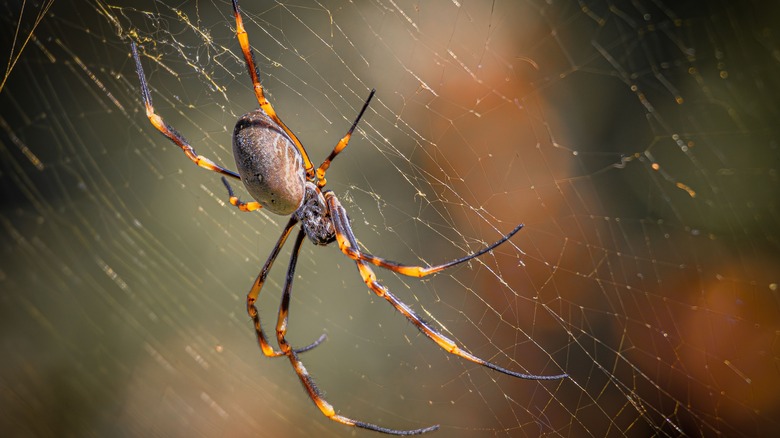The Spider Species That Produces Some Of The World's Finest Silk
As feared as they might be by large swathes of the global population, spiders have so many positives. For one thing, they're one of the most effective forms of natural pest control, but the fact they trap and devour bugs isn't necessarily going to do much for the arachnids' PR problems. A spider that can spin fine golden silk, however, might just cause even arachnophobes to think twice about their take on the eight-legged creatures.
These golden orb weavers, as they're known colloquially, once all belonged to the Nephila genus, but in 2018, several species were reclassified as belonging to the Trichonephila genus. Within this group sits several species, including one golden orb weaver known as the Banana spider and the Trichonephila inaurata, or red-legged golden orb-weaver, which can be found in South Africa and Indian Ocean islands including Madagascar. There are actually several golden orb-weaving spiders in the world, but the red-legged species is notable for having contributed to an extremely rare textile made from the silk of more than a million of its kind.
This species has a black body marked by a prominent yellow stripe surrounded by grey on the back. The legs look almost like tortoise-shell glasses frames, displaying a striking black and red, all of which is supposed to ward off predators. But even with such a unique look, the red-legged golden orb-weaver is most well known for its webs, which not only come in an equally impressive hue but are remarkably sturdy.
The golden orb-weaver might have the most impressive web of all spiders
Red-legged golden orb-weaver spiders, or red-legged golden orb web spiders, are just one of many golden orb weaving spiders, but they are among the most visually striking and have played a major role in the history of textiles created by weaving spider silk.
The species' webs can reach up to 6.5 feet in diameter and are constructed around a small "hub" at the center of the structure. The spider then spins its web with spiral threads which it weaves around the hub, and it's these reflective gold strands that have become such a point of fascination. The golden hue is surely one of the most impressive spider adaptations, and it's the result of a four-compound mixture. Xanthurenic acid, two quinones, and a fourth unknown compound combine to give the silk its unique color, which is thought to attract insects and other prey who flock to the golden webs when the sunlight hits them. The golden color is also thought to help camouflage the web when light conditions are lower.
The webs are also incredibly strong — about five times stronger than steel per unit weight — and are capable of trapping small birds and reptiles. The golden silk is even said to be stronger than Kevlar while retaining a flexibility even greater than that of nylon. This has only added to the fascination with golden orb-weavers, which ultimately led to the production of an incredible golden cape that used the silk of more than a million of the arachnids.
The golden silk cape made from orb-weaver silk
Spider silk has been used to create textiles at various points throughout the previous three centuries. In 1709, Frenchman Francois-Xavier Bon de Saint Hilaire created clothing for King Louis XIV, before Raimondo de Termeyer was said to have weaved stockings for Napoleon in the 19th century. The first large-scale weaving of spider silk, however, came in the late 1800s when French missionary Jacob Paul Camboué created a machine to extract the silk from 24 spiders at once, supposedly without harming them. Alongside his partner M. Nogué, Camboué farmed the silk of golden silk spiders in Madagascar and was said to have produced bed hangings which went on display at the 1900 Exposition Universells in Paris.
Those bed hangings have, however, since been lost. Now, the only known large textile made from spider silk is a cape made from the silk of more than a million female red-legged golden orb-weaver spiders. Finished in 2008, the golden silk cape was the product of five years of work whereby 80 people collected the arachnids from telephone poles in Madagascar. Each spider provided 80 feet of silk filament which was weaved together to make an 11-foot-by-4-foot cape. The cape and a separate 13-foot long scarf now represent the only examples of large spider silk textiles in the world.
While it might seem too delicate to be used for much more than supporting small arachnids, the spider silk has a remarkable tensile strength while also remaining elastic enough to adapt to changing scenarios. Unfortunately, harvesting spider silk is tricky business, and scientists have been trying for decades to replicate the silk synthetically. While they have come closer than ever in recent years, a real synthetic spider silk substitute remains elusive. All of which makes the Golden Spider Silk Cape even more remarkable for the fact it was made entirely using natural spider thread.


